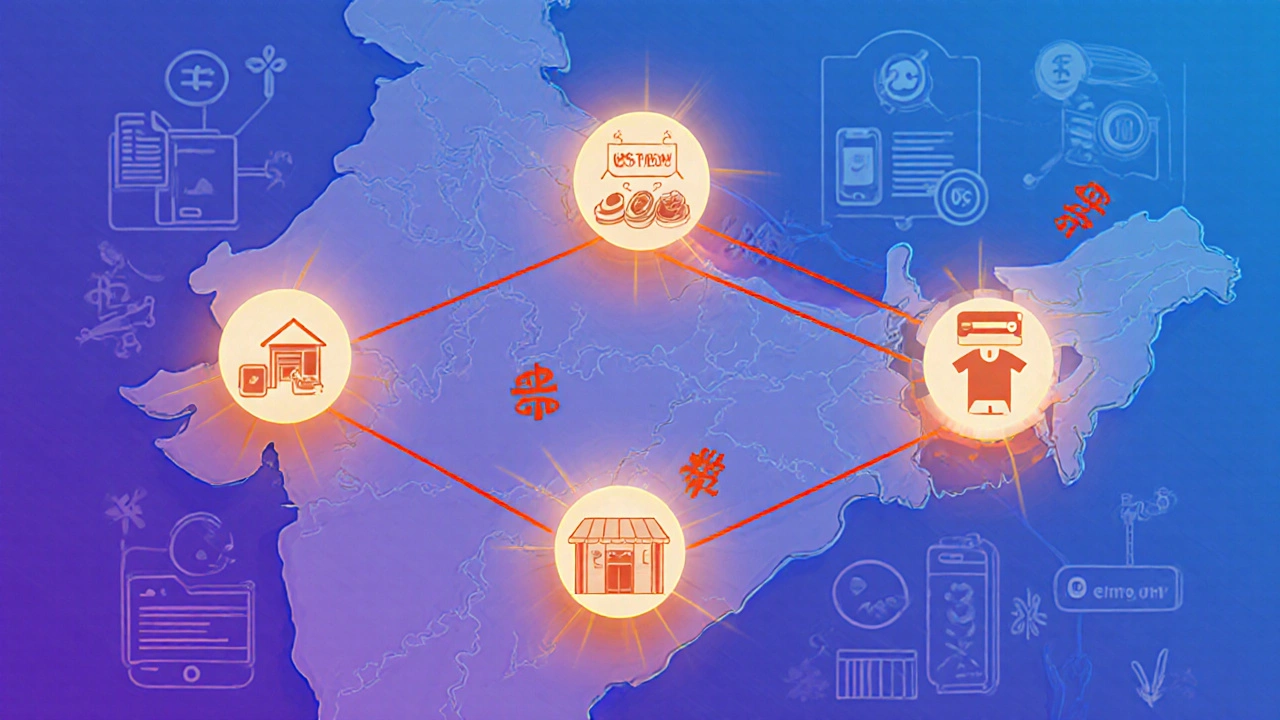Hyperlocal Business Profit Calculator
Calculate Your Micro-Business Potential
Estimate your monthly profit for hyperlocal businesses like home kitchen delivery, phone repairs, or organic produce. Based on real examples from the article.
Example: Home kitchen business: ₹120 sale price, ₹20 delivery cost, 50 jars/week = ₹4,000 weekly profit.
Your Profit Estimate
Based on industry examples from the article. Actual results may vary based on local demand and operational efficiency.
When people ask which business is the fastest in India, they’re not really asking about speed in the literal sense. They want to know: which business makes money the quickest after you start it? Which one turns cash into profit before your rent is due? Which one doesn’t need years of buildup to break even?
The answer isn’t a single company. It’s a model. A pattern. And right now, in 2025, that pattern is clear: hyperlocal delivery services powered by micro-warehousing.
Think about it. You don’t need a big warehouse. You don’t need a fleet of trucks. You don’t even need to own inventory. You just need to connect local sellers-home bakers, tailors, small electronics repair shops, organic farmers-with customers in a 3-5 km radius. And you do it in under 90 minutes.
Companies like Swiggy Instamart and Zepto proved this model works at scale. But here’s the real opportunity: you don’t have to be Zepto. You can be the Zepto of your neighborhood.
How a 3-Kilometer Business Can Outpace Big Tech
Big companies move slowly. They need approvals, compliance teams, and investor reports. A solo operator with a smartphone and a rented storage unit? They move faster.
Take a simple example: a woman in Pune starts a fresh pickle and chutney delivery service. She makes 50 jars a week in her kitchen. She lists them on WhatsApp, Instagram, and a basic Shopify store. She partners with a local bike courier who works part-time. Orders come in by 10 AM. Delivery happens by 1 PM. She pays ₹20 per delivery. She sells each jar for ₹120. Profit per jar? ₹80. Weekly profit? ₹4,000. In three months, she’s clearing ₹12,000 a month-with zero marketing spend beyond her phone.
This isn’t rare. In Hyderabad, a man runs a phone repair and accessory hub out of his garage. He doesn’t advertise on Google. He doesn’t need a website. He just shows up on local Facebook groups. He fixes phones in 45 minutes. Charges ₹400. Gets 15 jobs a week. That’s ₹6,000. Add phone cases, chargers, screen protectors-he’s pulling in ₹10,000 a week. His overhead? ₹2,000. Net profit? ₹8,000. No employees. No office. Just a bench, a screwdriver, and a WhatsApp group.
These aren’t startups. They’re micro-businesses. And they’re growing faster than any tech unicorn because they skip the heavy lifting.
Why These Businesses Win
There are five reasons why hyperlocal micro-businesses are the fastest-growing in India right now:
- No inventory risk - You don’t buy stock until someone pays. You’re selling on demand.
- Low startup cost - You can start with under ₹10,000. A phone, a small storage space, and a delivery partner.
- Instant cash flow - Customers pay upfront. You get paid the same day. No 30-day invoicing cycles.
- High margins - Local services and handmade goods have 60-80% profit margins. No middlemen cutting into your earnings.
- Scalable without complexity - Add one more delivery rider. Add one more seller. You don’t need an app. You don’t need funding.
Compare that to a traditional retail store. You need rent, lighting, staff, GST registration, inventory financing, and months of foot traffic before you see profit. A hyperlocal micro-business skips all that.
Top 5 Fastest-Growing Micro-Business Models in India (2025)
Here are the five models that are generating the fastest returns right now:
| Business Type | Startup Cost | Time to First Profit | Monthly Profit Potential | Key Tools Needed |
|---|---|---|---|---|
| Home Kitchen Food Delivery | ₹5,000-₹15,000 | 7-14 days | ₹25,000-₹80,000 | WhatsApp, Instagram, Packaged containers |
| Phone & Gadget Repair Hub | ₹8,000-₹20,000 | 5-10 days | ₹30,000-₹1,00,000 | Screwdrivers, spare parts, WhatsApp group |
| Local Organic Produce Aggregator | ₹3,000-₹10,000 | 10-20 days | ₹20,000-₹60,000 | Google Forms, bike courier, reusable bags |
| Custom T-Shirt & Merch Printing | ₹12,000-₹25,000 | 14-21 days | ₹40,000-₹1,20,000 | Print-on-demand partner, Instagram, Canva |
| Home-Based Tuition & Skill Coaching | ₹2,000-₹8,000 | 3-7 days | ₹15,000-₹50,000 | Zoom, Google Calendar, WhatsApp |
Notice something? None of these require a business license to start. Most don’t even need GST registration until you hit ₹20 lakh annual turnover. You can test them all with less than ₹20,000. And you can see profit in under two weeks.

What Doesn’t Work Anymore
Let’s be clear: not every business is fast anymore.
Traditional e-commerce stores with inventory? Too slow. You’re waiting for shipping, returns, and cash flow cycles. Amazon and Flipkart eat your margins.
Dropshipping? Still alive, but saturated. Profit margins are down to 5-8%. You’re competing with thousands of identical Shopify stores selling phone cases.
Franchises? High upfront cost. Long payback period. You’re locked into brand rules. Not fast. Not flexible.
YouTube channels? Takes 6-12 months to monetize. You need content, consistency, and algorithms on your side. Too slow for someone who needs income now.
The old playbook doesn’t work. The new one is simple: sell something local, fast, and personal.
How to Start One in 7 Days
Here’s how to launch a hyperlocal micro-business in a week:
- Day 1: Pick one thing you can make, fix, or source locally. Something people need every week. Food. Repairs. Tutoring. Plants. Pet food.
- Day 2: Take 5 photos. One of the product. One of you making it. One of the packaging. One of a happy customer (ask a friend). One of your workspace.
- Day 3: Create a free WhatsApp Business account. Set up a profile picture and bio. Write: “Fresh pickles delivered to your door. Order by 10 AM, get it by 1 PM.”
- Day 4: Join 5 local Facebook groups. Post your photos. No sales pitch. Just: “Made these mango pickles this morning. Limited stock. DM if you want one.”
- Day 5: Get your first 3 orders. Ask for cash on delivery. Don’t offer discounts. Just deliver fast.
- Day 6: Ask each customer: “Who else should I send this to?” Get 2 referrals.
- Day 7: Repeat. Add one more product. Add one more delivery zone.
That’s it. No website. No app. No investor. Just speed, trust, and consistency.

Real Numbers from Real People
In Bhopal, a 24-year-old man started a home-cooked thali delivery for office workers. He cooked 30 meals a day. Charged ₹100 per meal. Paid ₹15 to a delivery guy. Profit per meal? ₹85. Daily profit? ₹2,550. Monthly? ₹76,500. He didn’t quit his job. He did this after work. In 4 months, he hired two more cooks. Now he runs a small kitchen. No loan. No ad spend. Just word of mouth.
In Coimbatore, a retired teacher started handmade soap delivery using natural ingredients. She made 100 bars a week. Sold them for ₹80 each. Cost to make? ₹30. Profit? ₹50 per bar. Weekly profit? ₹5,000. She uses Instagram Stories. No website. She’s already cleared ₹3 lakh in profit this year.
These aren’t outliers. They’re examples of what happens when you stop chasing big funding and start chasing fast results.
Why This Will Keep Growing
India has over 120 million small businesses. Most of them are invisible. They don’t have websites. They don’t get media coverage. But they’re the real economy.
Urbanization is pushing people into apartments. They don’t have time to go to markets. They want things delivered fast. They trust their neighbor more than a big brand.
Mobile internet is cheap. WhatsApp is everywhere. UPI makes payments instant. These aren’t trends-they’re infrastructure.
The fastest business in India isn’t a company. It’s a mindset: start small, move fast, serve locally, and scale through trust.
If you’re waiting for the perfect idea, you’re too late. The perfect idea is already in your neighborhood. You just need to notice it.
Is it legal to run a home-based business in India?
Yes, absolutely. Most micro-businesses like food delivery, tutoring, or repairs operate legally under the MSME (Micro, Small, and Medium Enterprises) framework. You don’t need a formal business license to start selling locally. GST registration is only required if your annual turnover crosses ₹20 lakh. Many operators stay under this limit intentionally to avoid paperwork. Always check local municipal rules-some cities have restrictions on home kitchens, but enforcement is rare for small-scale operations.
Do I need an app or website to run a fast business?
No. Apps and websites add cost, complexity, and time. Most successful micro-businesses in India use WhatsApp, Instagram, Facebook Groups, and Google Forms. These tools are free, familiar, and trusted by customers. You can manage orders, payments, and delivery coordination with just your phone. Save the app for when you hit ₹5 lakh monthly revenue.
How do I get customers without spending on ads?
Word of mouth is your best ad. Start by offering your product to 5 friends or neighbors. Ask them to share it with one person each. Use local Facebook groups and WhatsApp communities. Post photos of your product with clear pricing and delivery times. People trust recommendations from people they know. Don’t run ads until you’ve proven you can deliver consistently. Once you have 10 loyal customers, you’ll get 10 more naturally.
Can I scale this into a bigger business later?
Yes, but don’t rush it. Many of the fastest-growing businesses in India started as one-person operations. Once you’re making consistent profit, you can hire a delivery rider, add another product line, or open a small storefront. But scaling too fast kills speed. The advantage of a micro-business is its agility. Keep it lean until you have real demand. Then expand step by step.
What’s the biggest mistake people make when starting?
Waiting for perfection. People spend weeks designing logos, building websites, and writing business plans. Meanwhile, someone else is already selling pickles from their kitchen and making ₹1,500 a day. The fastest businesses start with a rough product, a simple message, and a willingness to learn from real customers-not from books. Get feedback after your first sale. Adjust. Repeat. Speed beats polish every time.
If you’re looking for the fastest business in India, stop searching for the next big idea. Look around your street. Find what people need today. Make it simple. Deliver it fast. And let word of mouth do the rest.

